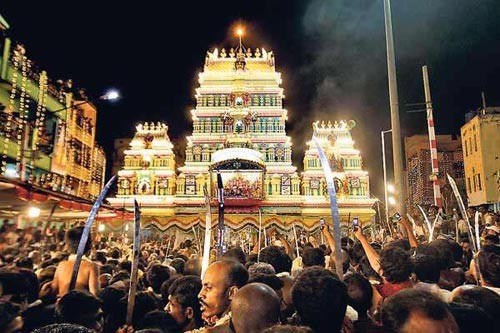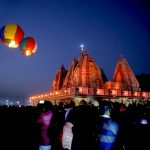Unlike in Ramayana very few characters from Mahabharatha are worshipped, so it may be a surprise for many that Draupadi from the epic is worshipped as Goddess Shakthi in South India. Draupadi entered the religious map of south India in the form of a village deity, connecting neighbouring villages with a message of togetherness. There are at least 800 temples dedicated to Draupadi in Tamil Nadu, Andhra Pradesh and Karnataka and many celebrate annual festival to celebrate the life of Draupadi.
The rituals followed by the Draupadi Amman cult continue to be relevant as they set a great example of harmony among human beings. Even though the folk cult is not popular, it remains active in parts of Tamil Nadu as “Thimithi Festival”. In Karnataka the “Karaga is an annual tradition practised by the Thigala community, traditionally gardeners and lakesettlers, which has now dispersed to other professions. In Andhra Pradesh it is an 18-day celebration in Chittor district.
Mythology
The main theme of the Mahabharata epic is the rivalry for the throne of the Kuru Dynasty between two groups of cousins: the five Pandava brothers and the Kaurava brothers. The rival groups grew up together at the court, but upon the death of their father, the Pandavas were forced to leave the kingdom, due to jealousy and enmity that had developed between them and the Kauravas.
During their exile, the five brothers jointly married Draupadi—to whom the temple of Udappuwa is dedicated—and met their cousin Krishna, who remained their friend thereafter. They returned to the divided kingdom for some years but were again exiled to the forest for twelve years when the eldest brother, Yudhisthira, lost everything, including Draupadi, in a game of dice with Duryodhana, the eldest of the Kauravas.
Duryodhana and his younger brother tried to disrobe Draupadi, but as they pulled off one sari, another took its place, thanks to the intervention of Krishna. For this attempt to dishonour her, Draupadi vowed vengeance upon Duryodhana; the ensuing feud culminated in a fierce battle lasting 18 days. Following the battle, the victorious Pandava brothers and Draupadi—now reunited to live in perpetual bliss—crossed a fire to expiate the sins committed during the fight.

Karaga festival – Karnataka
Karaga is a folk dance of Karnataka which originated as a ritual dedicated to Draupadi as known in these parts as Droupthamma. The ritual is performed on a full moon day.
The ritual pot filled with water and adorned with decorations several feet high is carried by the priest. The dancers perform various acrobatic feats while following the procession accompanied by a number of musical instruments like ‘Thavi’, “Nadaswaram”, “Muni”, “Udukka”, “Pamba”.
Though all villages, cities and towns celebrate “KAraga” in Karnataka, Bengaluru’s the most popular Karaga which attracts thousands of tourists. This year’s Karaga was performed on March 31st.
Legend
It is said that Draupadi, wife of the Pandavas, created an army of soldiers called Veerakumaras (hero sons) to kill a demon Timirasura. When it was time for Draupadi to go to heaven, the soldiers requested her to stay back. Draupadi, it goes, promised to visit Earth every year on the full moo moon of the first month of the Hindu calendar. Her visit marks the nine-day festival which culminates in the Karaga where Draupadi is worshipped as aadishakti.
Draupadi is a form of shakti that Dharmaraya worshipped. It was for peace that this Karaga is meant for. Draupadi devi is not installed in the temple here at the time of Karaga. She is put in as a chakrastapane, so that the devout get her darshan (view). Otherwise she is represented by a charka peeta. This representation of shakti is followed only by Thigalas. For over 800 years, the festival has been celebrated in the temple and never once has the goddess and chariot not left on their annual journey.

History
It is believed that in the 17th century, the Mysore maharaja invited scholars to establish the scriptural basis of the karaga performance. “…the word Karaga referred to two terms: “kara,” meaning “hand,” and “ga,”meaning “that which is held.” Since the Karaga — which refers to a water pot in Kannada — is carried in the left hand of the priest on the day of its “birth,” the festival is called the Karaga.
The karaga itself is a mud pot, on which stands a tall floral pyramid that is balanced on the carrier’s head. The contents of the pot have remained a secret down the centuries. The carrier’s arrival is heralded by hundreds of bare-chested, dhoti-clad, turbaned Veerakumaras bearing unsheathed swords. Tradition has it that this frenzied procession of Veerakumaras accompanying the karaga carrier can execute him should he stumble and let the karaga fall. This festival that takes place in central part of the city is called as Bangalore Karaga.
The Karaga carrier would be seen as a temporary avatar of Draupadi. A unique feature of the Karaga festival is that a man, dressed as a woman, carries the Karaga on his head. While a few say that it is a celebration of womanhood and femininity, a section claims that it is the result of Draupadi’s curse. It is seen as an insult to Yudhishthira, who let the Kauravas humiliate Draupadi in court.
In a gender-bending role that entails inter alia 11 days of asceticism, a man is chosen from the Acharya Pujari sect of the Tigala community, for it requires the physical strength of a male to carry the Karaga. Karaga priest performs austerities since six months and he wears his wife’s mangala sutra (Holy knot), who gets it back by a marriage ceremony on the 10th day. She will not be seeing her husband from the time of Vijayadashami who will reside in the temple till the Karaga is over. So when the Karaga procession stops in front of her house, she, unlike the other devotees cannot come out to be blessed. On the lines of Vijayadashami celebration of Dussera or Dasara, so also on the final day it’s triumph of good that the Karaga celebrates.
Bengaluru Karage
Bengaluru Karaga is celebrated at the Dharmaraya Swamy temple in Nagarathpete and it alsio the starting point of the jatre (procession), during which the priest, dressed as a woman, carries the karaga (a three-feet-tall pot symbolising Draupadi).
Legend has it that the jatre stopped in front of the Hazrat Tawakkul Mastan dargah and moved only when Mastan Baba, the patron saint, tied a thread on the foot of the priest carrying the karaga. The procession also stops at temples dedicated to Mariamma, Muthyalamma and Yellamma, who Draupadi is said to have considered her siblings.

Thimithi Festival – Tamil nadu
Tamil Nadu celebrates Draupadi though Thimithi, a ritualistic act of walking on fire. This festival being into the Hindu fold is celebrated a week before Diwali, during the month of Aipasi according to Tamil calendar. It is believed that after the Mahabahatha war, Draupadi had to walk on a bed of burning coal and come out unhurt, to prove her innocence. Thimithi is a festival celebrated to commemorate this event. Draupadi is worshipped as Draupadi Amman by a community of Tamilians known as Draupadi Amman cult. They consider Draupadi as their village Goddess and the rituals and festivals related to the Goddess is strictly observed. One such village in Tamil Nadu is Kondal in Nagapattinam district, where Draupadi Amman is their ‘Kula Devatha’ or village deity. Thimithi is a festival celebrated here.
Apart from Kondal, there are several other Draupadi temples spread across Tamil Nadu and Karnataka. Interestingly, devotees of the Goddess celebrate Thimithi in countries like Srilanka, Singapore, Malaysia, Mauritius and South Africa where a major part of the Indian population consist of Tamilians. The festival is celebrated during October-November.
The festival is followed by enacting the excerpts of Hindu epic Mahabharata where Draupadi walked down the fire to confirm her prowess and chastity by sticking to the path of ‘Dharma’. India is believed to be celebrating Thimithi for more than 2000 years.
Apart from the Draupadi story, the real meaning of this festival talks about the purificatory aspect of fire, or how it cleanses the ones who walk on it. Thimithi locally known as Poo Methipu , because of the color of the coal looks like heaps of Orange Flowers. This ritual is not gender based and is performed by both men and women. Sometimes even children take an active part in this ritual or they are mounted on the shoulder by either their mother or father. In Tamil Nadu, numerous villages conduct this annual event on a regular basis right in front of Mariamman (Goddess) temple. Devotees begin their ritual as early as 4 am and the event ends at 11 am. It is believed that if they are truly devoted to Draupadi they will walk through the fire unscathed.

Alugu Utsavam – Andhra Pradesh
In Andhra Pradesh’s Chittor district Draupadi is worshipped as Goddess shakthi and a 18 day Brahmotsavalu are organized during July – August after the Varalakshmi Vratham.
There is a Draupadi-Dharmarajula Swami temple in Puttur the last three days of the festival with the events of Alugu Utsavam and Agnigunda Pravesam, Rathotsavam are the most important days. On the eve of Alugu Utsavam, hundreds of devotees come from the Tamil-speaking belt of Puttur, Nagari, Nagalapuram and bordering villages in Tamil Nadu reach Puttur to take part in special pujas.
The highlight of this 250-year-old event is the consecration of the six-foot-high silver sword with its pointed edge mystically poised on the floor inside the temple. Goddess Draupadi is worshiped as an incarnation of Shakti in the form of mighty sword. This spectacle will be celebrated on Friday, followed by Varalakshmi Vratam. On Saturday, the deity will be taken in a grand procession through the arterial roads on a giant chariot.
On Sunday night, the event will draw to a close with the Agnigunda Pravesam, where the devout will walk on embers to fulfil their vows. Interestingly, after this ritual gets over, the giant sword, which remains balanced on its pointed edge, slightly tilts towards the sanctum sanctorum.
Local legend has it that when the people were afflicted by a mysterious disease, the elders on the word of a mendicant found an idol of Goddess Draupadi in an old well, and built a small temple, offering her prayers. Gradually, the impact of the disease reportedly vanished. In later years, a full-fledged temple replaced the small structure in the heart of Puttur.
Must Read GIFT A SMILE – EDUCATE A CHILD









